A Web-Based Visual and Analytical Geographical Information System for Oil and Gas Data
Abstract
:1. Introduction
- (1)
- Most systems were developed in traditional single-point access structure. Users usually purchase the software licenses and install standalone software on their desktops. The standalone software prevents engineers from collaborating toward some common goals, due to the limited access of the data.
- (2)
- More importantly, swift and agile oil and gas data visualization and analytic tools are absent. Data visualization and analytic methods are critical for production optimization, since multi-sourced, fast accumulating oil and gas data require diverse spatiotemporal handling methods to explore hidden patterns. The combination of the two methods is necessary to generate quantitative analytic results, as well present intelligible human-computer communication.
- (1)
- The design and implementation of the web-based geographical information system (GIS) platform OGVES to visualize and analyze oil and gas data. This system provides functions to store, search, visualize and analyze large volumes of oil and gas data. As a web-based system, OGVES provides better accessibility and more convenient data exploration methods than traditional desktop systems.
- (2)
- The proposal and development of a set of visualization and analytic methods to explore spatiotemporal patterns in oil and gas data. Spatial scales and temporal primitives contained in oil and gas data are discussed. Different visualization and analytic methods are then presented to explore and represent oil and gas data.
2. Related Works
2.1. Oil and Gas Data Management Systems
2.2. Visualization of Spatiotemporal Data
3. Web-Based Oil and Gas Visual Exploration System (OGVES)
3.1. OGVES Framework
3.2. Web GIS User Interface
3.3. Data Description and Structure
4. Analytical and Visualization Methods in OGVES
4.1. Analytical Methods
4.1.1. Cluster Analysis
4.1.2. Classification Analysis
4.1.3. Association Rule Mining (ARM)
4.1.4. Symbolic Tree Model Prediction
4.2. Visualization Design in OGVES
4.2.1. Visualization Based on Spatial Scale
- Global exploration focuses on presenting an intuitive overview of the whole study area. Data selection, query and location are also implemented in this phase. Users can filter interested projects, pads and wells, as well as check the status of all wells and the production data at a specific time. This phase also enables the display of comprehensive production data of the interested region, such as with a bubble map. This is the overview phase.
- Group exploration focuses on revealing the production patterns for each pad or group of pads. After selecting variable pads, users can check how corresponding production, injection and steam-to-oil ratio (SOR, an important measure of efficiency for SAGD production) data change with time and try to discover trends and periodicity. Users can also see when the operation status presents abnormal, and compare multiple pads in a specified period. This is the zoom and filter phase.
- Unit exploration focuses on discovering details of specific wells or pads. Users can use various visualization techniques and multidimensional charts or graphs to inspect selected detailed well data. This is the details-on-demand phase.
4.2.2. Visualization Based on Temporal Primitive
4.3. Visualization Methods for Oil and Gas Data
4.3.1. Classic Visualization Templates
4.3.2. Visualization Based on VISM
4.3.3. Visualization for Data Analytics Results
4.4. Summary of Visualization for Oil and Gas Production Data
5. Case Studies
5.1. Case 1: What Steam Injection Strategies Should Be Adopted for SAGD Wells and How Will Each Strategy Affect Well Production?
5.2. Case 2: Will a New Shale Gas Well Reach Expected Production at a Specific Instant?
6. Evaluation
7. Conclusions and Future Work
Acknowledgments
Author Contributions
Conflicts of Interest
References
- Wei, B.; Silva, R.; Wang, X. A web-based Steam Assisted Gravity Drainage (SAGD) data visualization and analytical system. In Proceedings of the 14th International Symposium on Web and Wireless GIS (W2GIS 2015), Grenoble, France, 21–22 May 2015.
- Divestco. Available online: http://www.divestco.com (accessed on 21 October 2016).
- IHS. Available online: http://www.ihs.com (accessed on 21 October 2016).
- Katalyst Data Management. Available online: http://www.katalystdm.com (accessed on 21 October 2016).
- GeoLOGIC Systems Ltd. Available online: http://www.geologic.com (accessed on 21 October 2016).
- Government of Saskatchewan. Available online: http://www.infomaps.gov.sk.ca (accessed on 2 March 2017).
- Petrol Global News. Available online: https://petroglobalnews.com/ (accessed on 2 March 2017).
- Noah, S.A.; Yaakob, S.; Shahar, S. Application of information visualization techniques in representing patients’ temporal personal history data. In Visual Informatics: Bridging Research and Practice; Springer: Berlin/Heidelberg, Germany, 2009; pp. 168–179. [Google Scholar]
- Thomas, J.J.; Cook, K.A. A visual analytics agenda. IEEE Comput. Graph. Appl. Mag. 2006, 26, 10–13. [Google Scholar] [CrossRef]
- Lee, H.Y.; Ong, H.L. Visualization support for data mining. IEEE Intell. Syst. 2006, 11, 69–75. [Google Scholar]
- Miller, H.J.; Han, J. (Eds.) Geographic Data Mining and Knowledge Discovery; CRC Press: Boca Raton, FL, USA, 2009.
- Ko, S.; Maciejewski, R.; Jang, Y.; Ebert, D.S. Marketanalyzer: An interactive visual analytics system for analyzing competitive advantage using point of sale data. Comput. Graph. Forum 2012, 31, 1245–1254. [Google Scholar] [CrossRef]
- ElHakim, R.; ElHelw, M. Interactive 3d visualization for wireless sensor networks. Vis. Comput. 2010, 26, 1071–1077. [Google Scholar] [CrossRef]
- Trimm, D.; Rheingans, P.; desJardins, M. Visualizing student histories using clustering and composition. IEEE Trans. Vis. Comput. Graph. 2012, 18, 2809–2818. [Google Scholar] [CrossRef] [PubMed]
- Pileggi, H.; Stolper, C.D.; Boyle, J.M.; Stasko, J.T. Snapshot: Visualization to propel ice hockey analytics. IEEE Trans. Vis. Comput. Graph. 2012, 18, 2819–2828. [Google Scholar] [CrossRef] [PubMed]
- Tan, L.; Song, Y.; Liu, S.; Xie, L. Imagehive: Interactive contentaware image summarization. IEEE Comput. Graph. Appl. 2012, 32, 46–55. [Google Scholar] [CrossRef] [PubMed]
- Nocaj, A.; Brandes, U. Organizing search results with a reference map. IEEE Trans. Vis. Comput. Graph. 2012, 18, 2546–2555. [Google Scholar] [CrossRef] [PubMed]
- Von Landesberger, T.; Bremm, S.; Andrienko, N.; Andrienko, G.; Tekušová, M. Visual analytics methods for categoric spatio-temporal data. In Proceedings of the IEEE Symposium on Visual Analytics Science and Technology, Seattle, WA, USA, 14–19 October 2012; pp. 183–192.
- Ferreira, N. Visual exploration of big spatio-temporal urban data: A study of New York City taxi trips. IEEE Trans. Vis. Comput. Graph. 2013, 19, 2149–2158. [Google Scholar] [CrossRef] [PubMed]
- Wang, Z. Visual exploration of sparse traffic trajectory data. IEEE Trans. Vis. Comput. Graph. 2014, 20, 1813–1822. [Google Scholar] [CrossRef] [PubMed]
- Mazumdar, S.; Kauppinen, T. Visualizing and animating large-scale spatiotemporal data with ELBAR explorer. In Proceedings of the 2014 International Conference on Posters & Demonstrations Track; CEUR-WS.org: Aachen, Germany, 2014; Volume 1272, pp. 161–164. [Google Scholar]
- Tatu, A. Automated analytical methods to support visual exploration of high-dimensional data. IEEE Trans. Vis. Comput. Graph. 2011, 17, 584–597. [Google Scholar] [CrossRef] [PubMed]
- Gebbert, S.; Pebesma, E. A temporal GIS for field based environmental modeling. Environ. Model. Softw. 2014, 53, 1–12. [Google Scholar] [CrossRef]
- Hengl, T.; Roudier, P.; Beaudette, D.; Pebesma, E. plotKML: Scientific visualization of spatio-temporal data. J. Stat. Softw. 2015, 63, 1–25. [Google Scholar] [CrossRef]
- Evans, F.; Volz, W.; Dorn, G.; Frohlich, B.; Roberts, D.M. Future trends in oil and gas visualization. In Proceedings of the Conference on Visualization 2002 (VIS 2002), Boston, MA, USA, 27 October–1 November 2002; pp. 567–570.
- Anderson, D.M.; Nobakht, M.; Moghadam, S.; Mattar, L. Analysis of production data from fractured shale gas wells. In Proceedings of the SPE Unconventional Gas Conference, Pittsburgh, PA, USA, 23–25 February 2010.
- Baihly, J.D.; Altman, R.M.; Malpani, R.; Luo, F. Shale gas production decline trend comparison over time and basins. In Proceedings of the SPE Annual Technical Conference and Exhibition, Pittsburgh, PA, USA, 23–25 February 2010.
- Nobakht, M.; Mattar, L.; Moghadam, S.; Anderson, D.M. Simplified forecasting of tight/shale-gas production in linear flow. J. Can. Pet. Technol. 2012, 51, 476–486. [Google Scholar] [CrossRef]
- Bostock, M.; Ogievetsky, V.; Heer, J. D³ data-driven documents. IEEE Trans. Vis. Comput. Graph. 2011, 17, 2301–2309. [Google Scholar] [CrossRef] [PubMed]
- Hall, M.; Frank, E.; Holmes, G.; Pfahringer, B.; Reutemann, P.; Witten, I.H. The WEKA data mining software: An update. ACM SIGKDD Explor. Newsl. 2009, 11, 10–18. [Google Scholar] [CrossRef]
- Deoliveira, J. GeoServer: Uniting the GeoWeb and spatial data infrastructures. In Proceedings of the 10th International Conference for Spatial Data Infrastructure, St. Augustine, Trinidad, 25–29 February 2008.
- Google Maps APIs. Available online: https://developers.google.com/maps/ (accessed on 21 October 2016).
- Darwin, P.B.; Kozlowski, P. AngularJS Web Application Development; Packt Publishing: Birmingham, UK, 2013. [Google Scholar]
- Momjian, B. PostgreSQL: Introduction and Concepts; Addison-Wesley: New York, NY, USA, 2001. [Google Scholar]
- Tilkov, S.; Vinoski, S. Node.js: Using JavaScript to build high-performance network programs. IEEE Internet Comput. 2010, 14, 80–83. [Google Scholar] [CrossRef]
- Han, J.; Pei, J.; Kamber, M. Data Mining: Concepts and Techniques; Elsevier: Amsterdam, The Netherlands, 2011. [Google Scholar]
- Liu, S.; Xue, L. The application of fuzzy clustering to oil and gas evaluation. In Proceedings of the Fuzzy Systems and Knowledge Discovery, Fifth International Conference on Fuzzy Systems and Knowledge Discovery, Jinan, Shandong, China, 25–27 August 2008.
- Aulia, A.; Keat, T.B.; Maulut, M.S.; El-Khatib, N.; Jasamai, M. Smart oilfield data mining for reservoir analysis. Int. J. Eng. Technol. 2010, 10, 78–88. [Google Scholar]
- Cai, Y.; Wang, X.; Hu, K.; Dong, M. A data mining approach to finding relationships between reservoir properties and oil production for CHOPS. Comput. Geosci. 2014, 73, 37–47. [Google Scholar] [CrossRef]
- Agrawal, R.; Srikant, R. Fast algorithms for mining association rules in large databases. In Proceedings of the 20th International Conference on Very Large Data Bases, San Francisco, CA, USA, 12–15 September 1994; pp. 487–499.
- Wei, B.; Pinto, H.; Wang, X. A symbolic tree model for oil and gas production prediction using time-series production data. In Proceedings of the 2016 IEEE International Conference on Data Science and Advanced Analytics (DSAA2016), Montreal, QC, Canada, 17–19 October 2016.
- Shneiderman, B. The eyes have it: A task by data type taxonomy for information visualizations. In Proceedings of the IEEE Symposium on Visual Languages, Boulder, CO, USA, 3–6 September 1996; pp. 336–343.
- Aigner, W. Visualization of Time-Oriented Data; Springer: Berlin/Heidelberg, Germany, 2011. [Google Scholar]
- Maylor, H. Beyond the Gantt chart: Project management moving on. Eur. Manag. J. 2001, 19, 92–100. [Google Scholar]
- A Web-based System Prototype in Testing. Available online: https://www.youtube.com/watch?v=y3m5YzqJxwA (accessed on 20 January 2017).
- Brunet, R. La carte-modèle et les chorèmes. Mappemonde 1986, 4, 4–6. [Google Scholar]
- Parisi, T. WebGL: Up and Running; O’Reilly Media, Inc.: Sebastopol, CA, USA, 2012. [Google Scholar]
- Harrie, L. Analytical estimation of map readability. ISPRS Int. J. Geo-Inf. 2015, 4, 418–446. [Google Scholar] [CrossRef]
- Li, S.; Dragicevic, S.; Castro, F.A.; Sester, M.; Winter, S.; Coltekin, A.; Pettit, C. Geospatial big data handling theory and methods: A review and research challenges. ISPRS J. Photogramm. Remote Sens. 2016, 115, 119–133. [Google Scholar] [CrossRef] [Green Version]
- Al-Bulushi, N. Development of artificial neural network models for predicting water saturation and fluid distribution. J. Pet. Sci. Eng. 2009, 68, 197–208. [Google Scholar] [CrossRef]
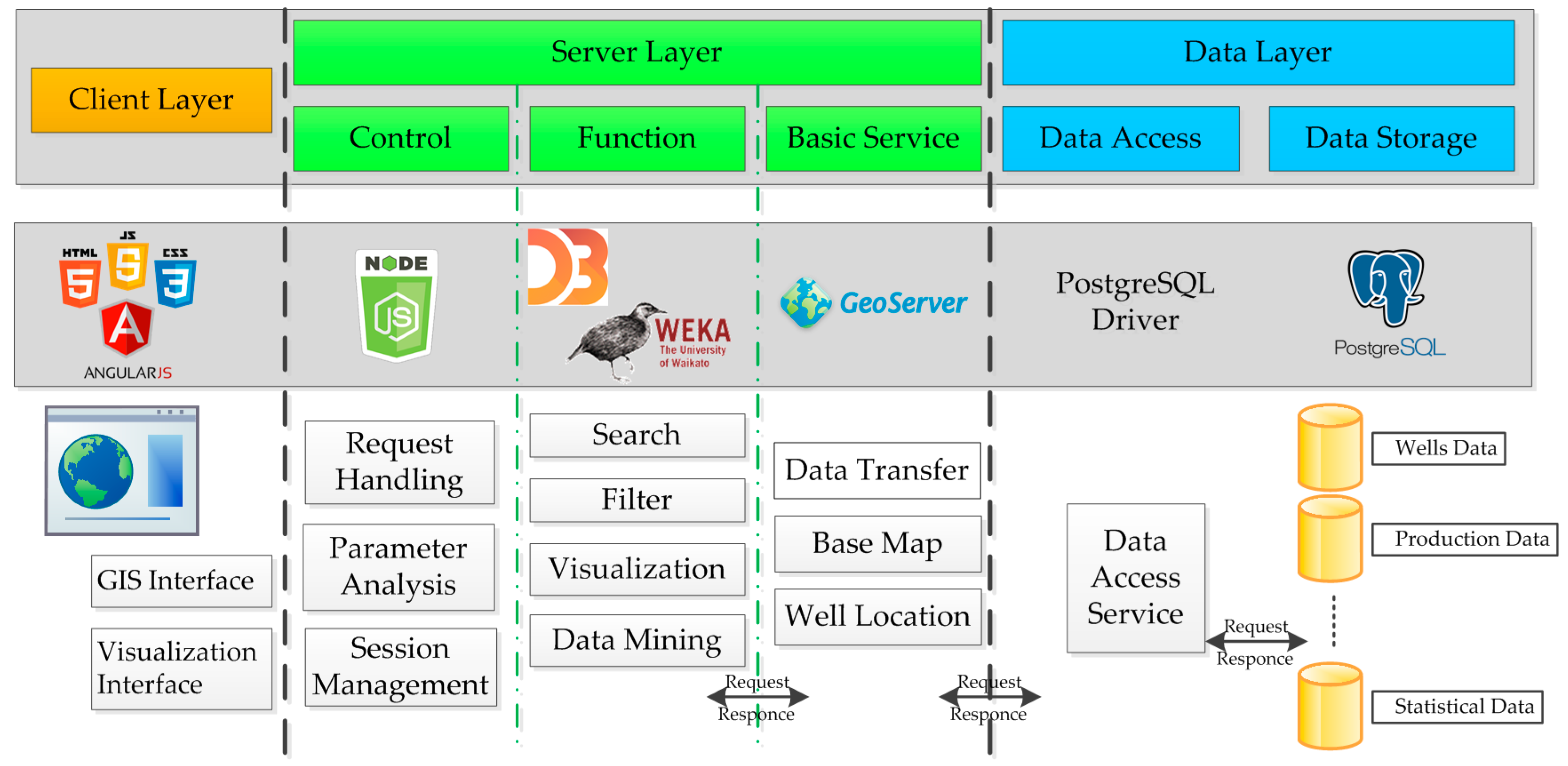



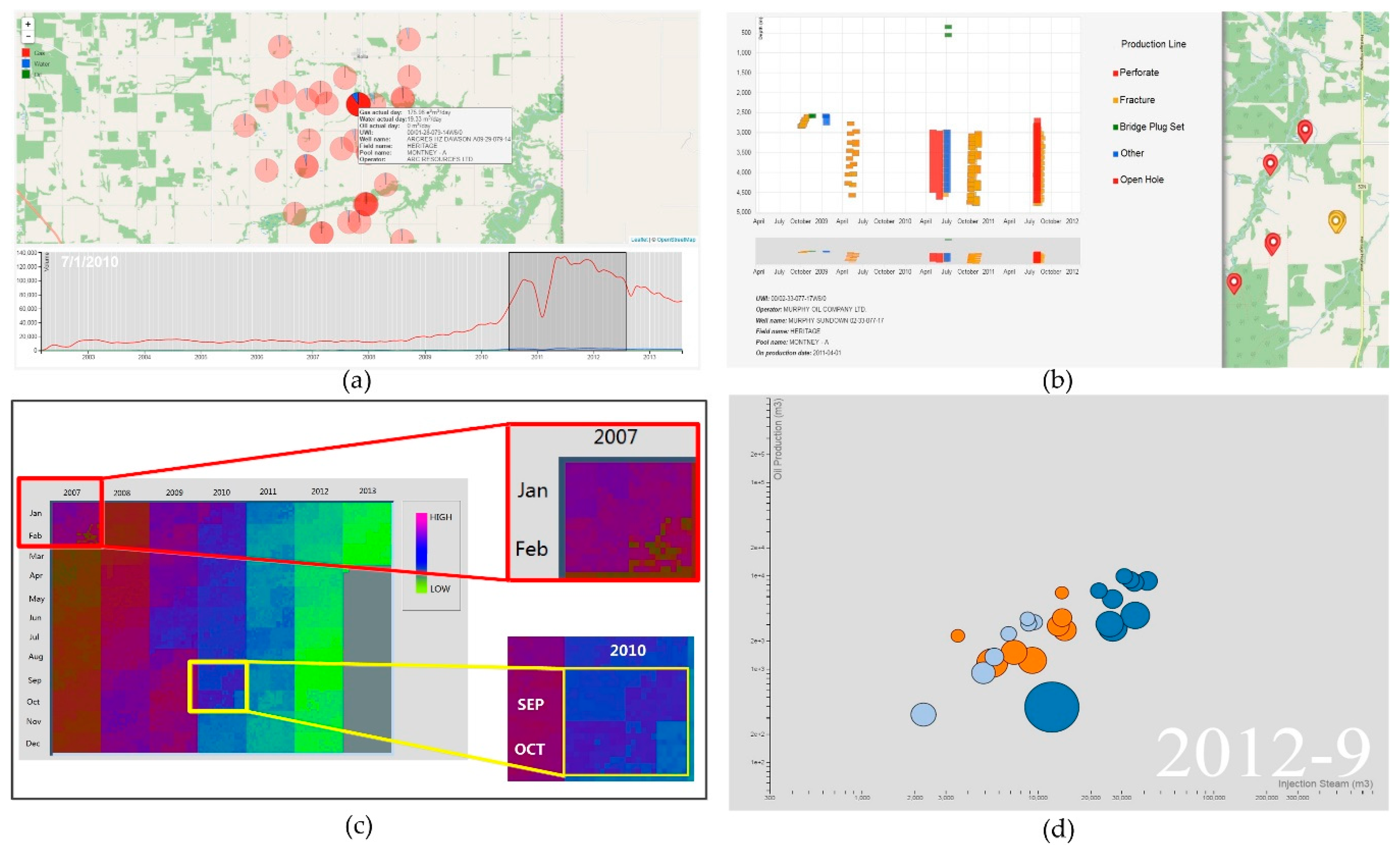

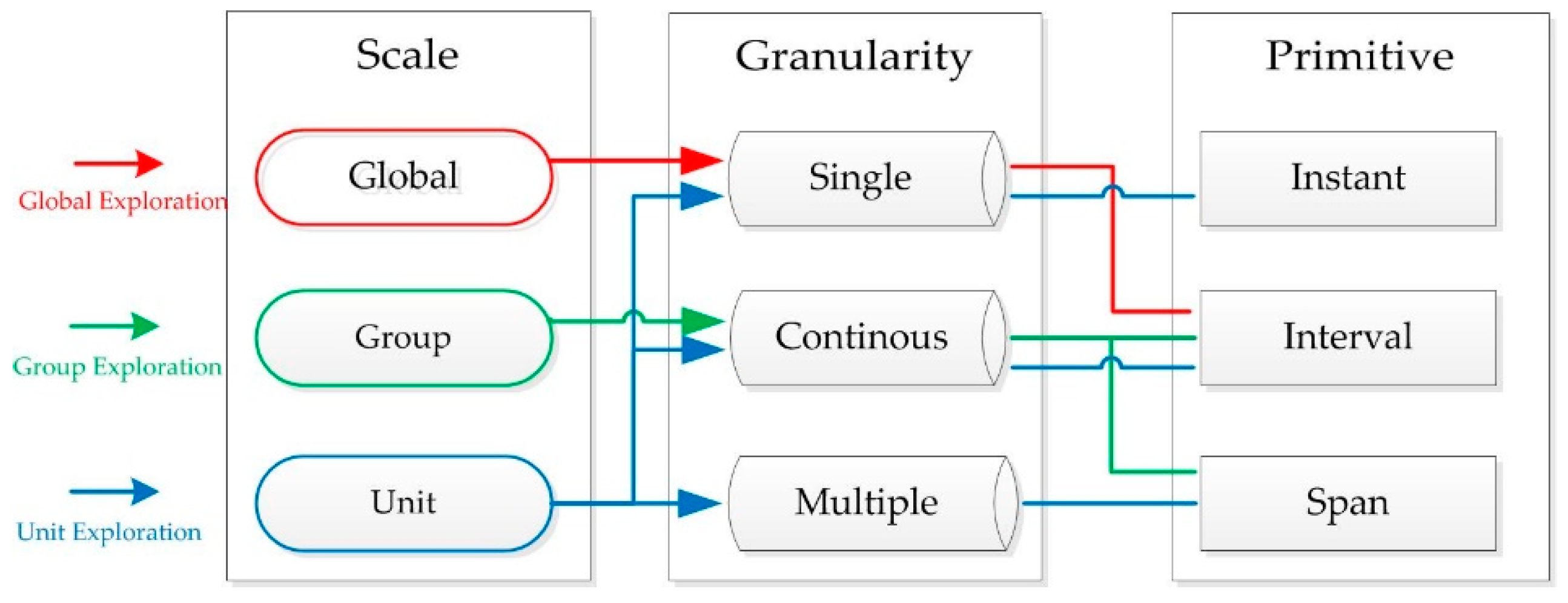
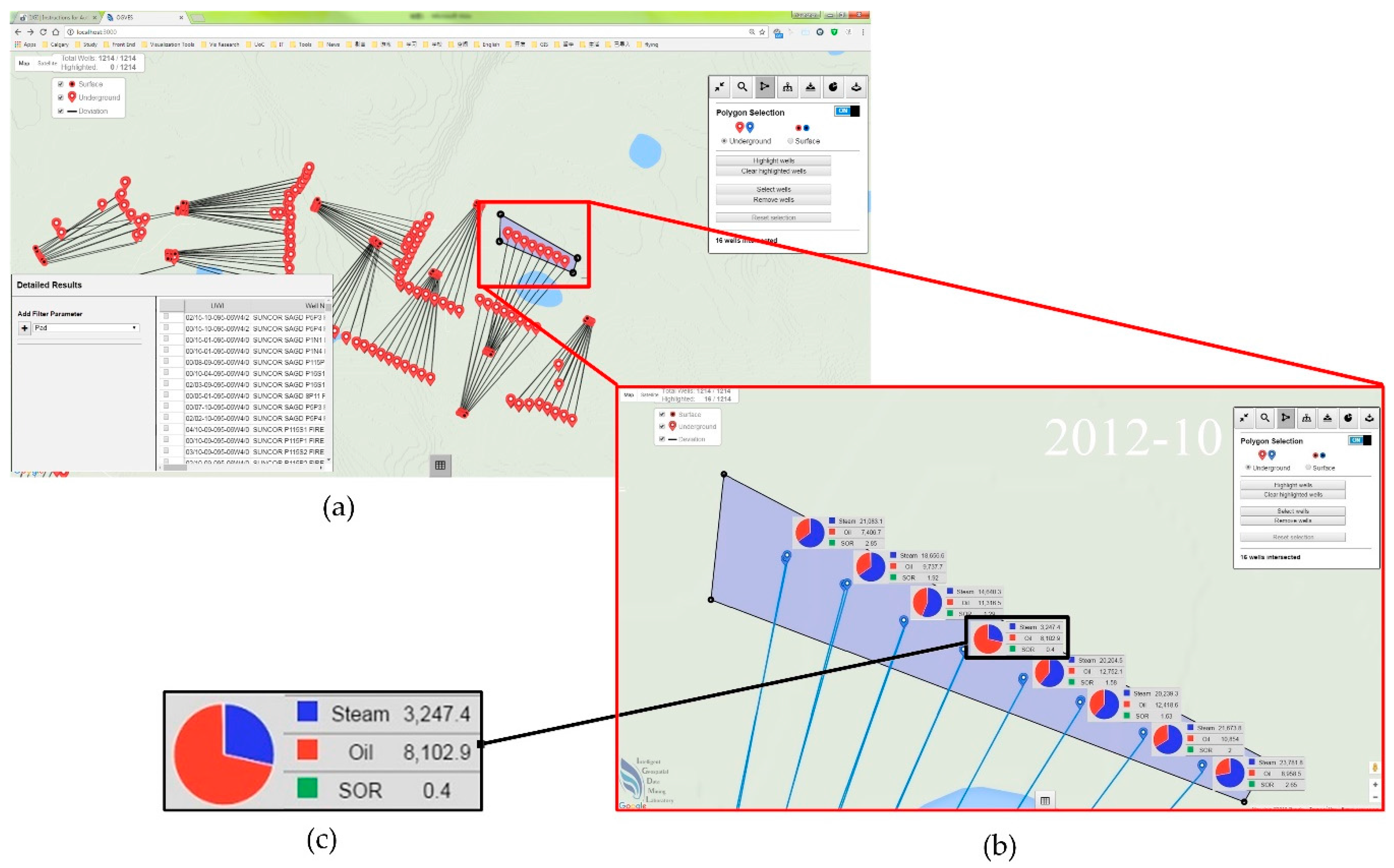
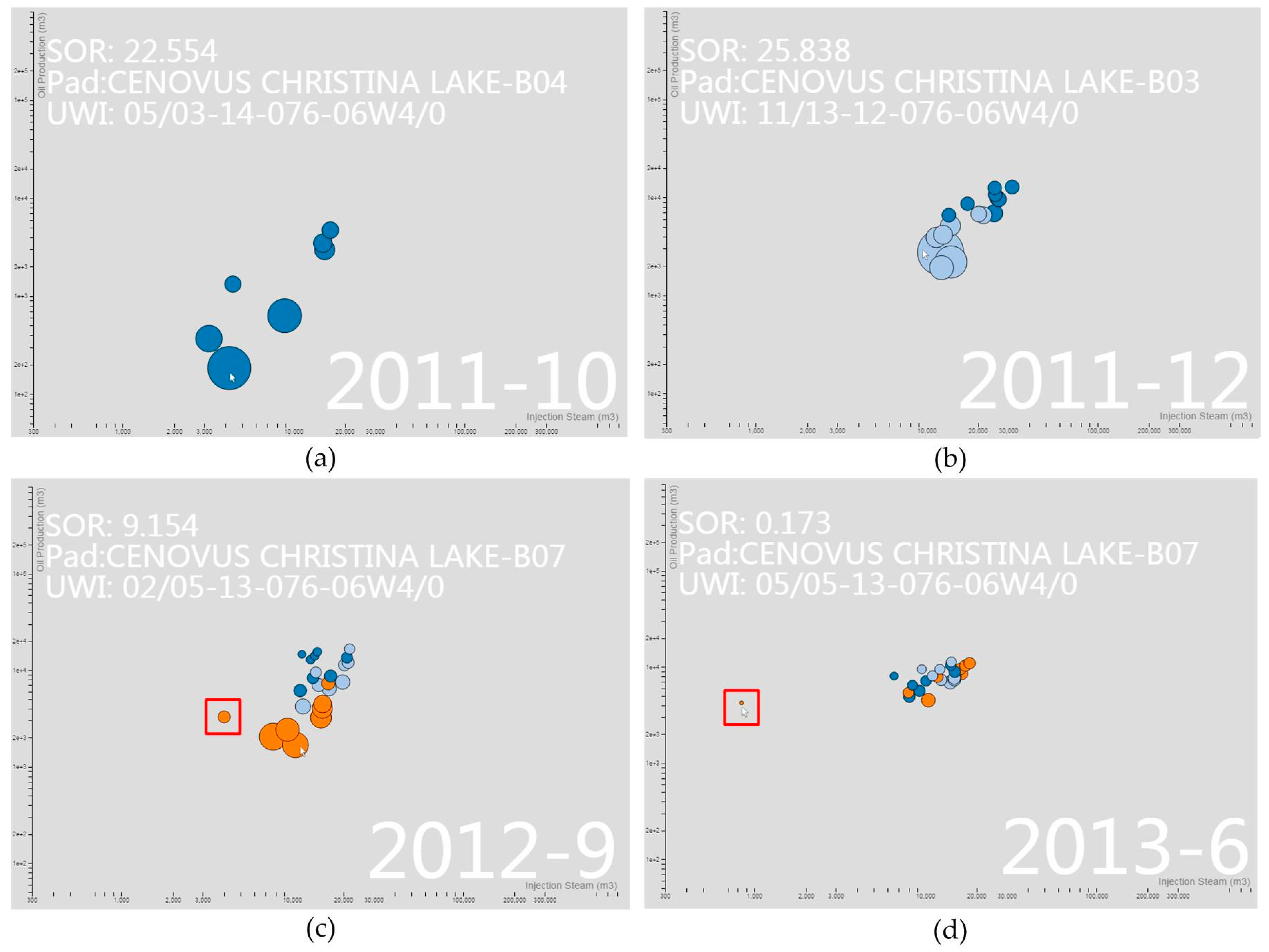



| VISUALIZATION METHODS | SPATIAL SCALE | TEMPORAL PRIMITIVE | DATA TYPE | DATA SOURCE | ||||||
|---|---|---|---|---|---|---|---|---|---|---|
| Unit | Group | Global | Instant | Interval | Span | Numeric | Nominal | Raw Data | Analytic Results | |
| Bubble Map | ● | ● | ● | ● | ● | |||||
| Completion Map | ● | ● | ● | ● | ||||||
| Pixel Table | ● | ● | ● | ● | ● | ● | ||||
| Animation Chart | ● | ● | ● | ● | ● | ● | ● | |||
| Production Data Mining Visualization | ● | ● | ● | ● | ● | |||||
| Task Description | General Questions | Average Rating |
|---|---|---|
| T1. Freely browse the whole oil and gas data | Does OGVES provide sufficient data management functions? | 4.4 |
| T2. Try to visualize data of interest based on user preferences | Does the Global-Group-Unit workflow represent VISM? | 4.9 |
| T3. Compare visualization methods designed on VISM with classic techniques | Is OGVES helpful in exploring oil and gas data in different levels? | 4.6 |
| T4. Use data analytic functions to discover hidden production features | Is OGVES helpful in discovering relationships among production-related data? | 4.6 |
| Does OGVES help you find previously unknown or vague knowledge? | 4.7 |
| OGVES | GeoCarta | iGlass | ||
|---|---|---|---|---|
| Architecture | Web-Based | Desktop-Based | Web-Based | |
| Deployment | Open-Source | Third-Party Commercial Platform | Third-Party Commercial Platform | |
| Cartography | - | ● | ● | |
| Data Management | ● | ● | ● | |
| Data Visualization | Classical | ● | ● | ● |
| Bubble Map | ● | - | - | |
| Pixel Tables | ● | - | - | |
| Animation Chart | ● | - | - | |
| Hierarchical Interface | ● | - | - | |
| Data Analysis | Statistical | ● | ● | ● |
| Classification | ● | ● | ● | |
| Clustering | ● | - | - | |
| Association Rule Mining | ● | - | - | |
| Prediction | ● | - | - | |
© 2017 by the authors. Licensee MDPI, Basel, Switzerland. This article is an open access article distributed under the terms and conditions of the Creative Commons Attribution (CC BY) license ( http://creativecommons.org/licenses/by/4.0/).
Share and Cite
Li, Y.; Wei, B.; Wang, X. A Web-Based Visual and Analytical Geographical Information System for Oil and Gas Data. ISPRS Int. J. Geo-Inf. 2017, 6, 76. https://0-doi-org.brum.beds.ac.uk/10.3390/ijgi6030076
Li Y, Wei B, Wang X. A Web-Based Visual and Analytical Geographical Information System for Oil and Gas Data. ISPRS International Journal of Geo-Information. 2017; 6(3):76. https://0-doi-org.brum.beds.ac.uk/10.3390/ijgi6030076
Chicago/Turabian StyleLi, Yuanchen, Bingjie Wei, and Xin Wang. 2017. "A Web-Based Visual and Analytical Geographical Information System for Oil and Gas Data" ISPRS International Journal of Geo-Information 6, no. 3: 76. https://0-doi-org.brum.beds.ac.uk/10.3390/ijgi6030076





